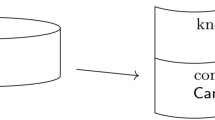Abstract
This paper shows how to increase the expressivity of concept languages using a strategy called hybridization. Building on the well-known correspondences between modal and description logics, two hybrid languages are defined. These languages are called 'hybrid' because, as well as the familiar propositional variables and modal operators, they also contain variables across individuals and a binder that binds these variables. As is shown, combining aspects of modal and first-order logic in this manner allows the expressivity of concept languages to be boosted in a natural way, making it possible to define number restrictions, collections of individuals, irreflexivity of roles, and TBox- and ABox-statements. Subsequent addition of the universal modality allows the notion of subsumption to be internalized, and enables the representation of queries to arbitrary first-order knowledge bases. The paper notes themes shared by the hybrid and concept language literatures, and draws attention to a little-known body of work by the late Arthur Prior.
Similar content being viewed by others
References
P. Blackburn, Nominal tense logic, Notre Dame J. Formal Logic 34 (1993) 56–83.
P. Blackburn, Modal logic and attribute value structures, in: Diamonds and Defaults, ed. M. de Rijke, Synthese Language Library, Vol. 229 (Kluwer, Dordrecht, 1993) pp. 19–65.
P. Blackburn, Structures, languages and translations: the structural approach to feature logic, in: Constraints, Language and Computation, eds. Rupp, Rosner and Johnson (Academic Press, New York, 1994) pp. 1–27.
P. Blackburn, Internalizing labeled deduction, in progress (1998). Will be made available at http://www.coli.uni-sb.de/~patrick/.
P. Blackburn and J. Seligman, Hybrid languages, J. Logic Language Information 4 (1995) 251–272.
P. Blackburn and J. Seligman, What are Hybrid Languages?, in: Advances in Modal Logic, Vol. 1, eds. Kracht, de Rijke, Wansing and Zakharyaschev (CSLI Publications, 1998) pp. 41–62.
P. Blackburn and E. Spaan, A modal perspective on the computational complexity of attribute value grammar, J. Logic Language Information 2 (1993) 129–169.
P. Blackburn and M. Tzakova, Hybrid completeness, Logic J. IGPL 4 (1998) 625–650.
P. Blackburn and M. Tzakova, Hybrid languages and temporal logic, to appear in Logic J. IGPL (1998).
G. Boolos and R. Jeffrey, Computability and Logic, 3rd ed. (Cambridge University Press, Cambridge, 1989).
R. Bull, An approach to tense logic, Theoria 36 (1970) 282–300.
M. de Rijke, The modal logic of inequality, J. Symbolic Logic 57 (1992) 177–241.
M. de Rijke, Meeting some neighbours, in: Logic and Information Flow, eds. J. van Eijck and A. Visser (MIT Press, Cambridge, MA, 1994) 170–195.
F. Donini, M. Lenzerini, D. Nardi and A. Schaerf, Reasoning in description logics, in: Principles of Knowledge Representation, ed. G. Brewka, Studies in Logic, Language and Information (CSLI Publications, Stanford University, 1996).
D. Gabbay, Investigations in Modal and Tense Logics with Applications to Problems in Philosophy and Linguistics, Synthese Library, Vol. 92 (D. Reidel, Dordrecht, 1976).
G. Gargov and V. Goranko, Modal logic with names, J. Philos. Logic 22 (1993) 607–636.
V. Goranko, Hierarchies of modal and temporal logics with reference pointers, J. Logic Language Inform. 5 (1996) 1–24.
V. Goranko, An interpretation of computational tree logics into temporal logics with reference pointers, Verslagreeks van die Department Wiskunde, RAU, Nommer 2/96, Department of Mathematics, Rand Afrikaans University, Johannesburg, South Africa (1996).
V. Goranko and S. Passy, Using the universal modality, J. Logic Comput. 2 (1992) 5–20.
G. Hughes and M. Cresswell, A New Introduction to Modal Logic (Routledge, 1996).
N. Kurtonina and M. de Rijke, Classifying description logics, in: Proceedings International Workshop on Description Logics, DL' 97 (1997).
C. Lewis, A Survey of Symbolic Logic (University of California Press, 1918).
S. Passy and T. Tinchev, Quantifiers in combinatory PDL: completeness, definability, incompleteness, in: Fundamentals of Computation Theory FCT' 85, Lecture Notes in Computer Science, Vol. 199 (Springer, New York, 1985) pp. 512–519.
S. Passy and T. Tinchev, An essay in combinatory dynamic logic, Information Comput. 93 (1991) 263–332.
A. Prior, Past, Present and Future (Oxford University Press, Oxford, 1967).
A. Prior and K. Fine, Worlds, Times, and Selves (University of Massachusetts Press, Cambridge, MA, 1977).
M. Reape, An introduction to the semantics of unification-based grammar formalisms, DYANA deliverable R3.2.A, ESPRIT basic research action BR 3175, Centre for Cognitive Science, University of Edinburgh, Scotland (1991).
M. Reape, A feature value logic, in: Constraints, Language and Computation, eds. Rupp, Rosner and Johnson (Academic Press, New York, 1994) pp. 77–110.
K. Schild, A correspondence theory for terminological logics: Preliminary report, in: Proc. of IJCAI' 91 (1991) 466–471.
M. Schmidt-Schauß and G. Smolka, Attributive concept descriptions with complements, Artificial Intelligence 48(1) (1991) 1–26.
J. Seligman, The logic of correct description, in: Advances in Intensional Logic, ed. M. de Rijke (Kluwer, Dordrecht, 1997) 107–135.
J. Seligman, Proof theory for contextual reasoning, in progress (1998).
M. Tzakova, Tableau calculi for hybrid logics, in progress (1998). Will be made available at http://www.mpi-sb.mpg.de/~tzakova/.
W. van der Hoek and M. de Rijke, Counting objects, J. Logic Comput. 5(3) (1995) 325–345.
Author information
Authors and Affiliations
Rights and permissions
About this article
Cite this article
Blackburn, P., Tzakova, M. Hybridizing concept languages. Annals of Mathematics and Artificial Intelligence 24, 23–49 (1998). https://doi.org/10.1023/A:1018988913388
Issue Date:
DOI: https://doi.org/10.1023/A:1018988913388




